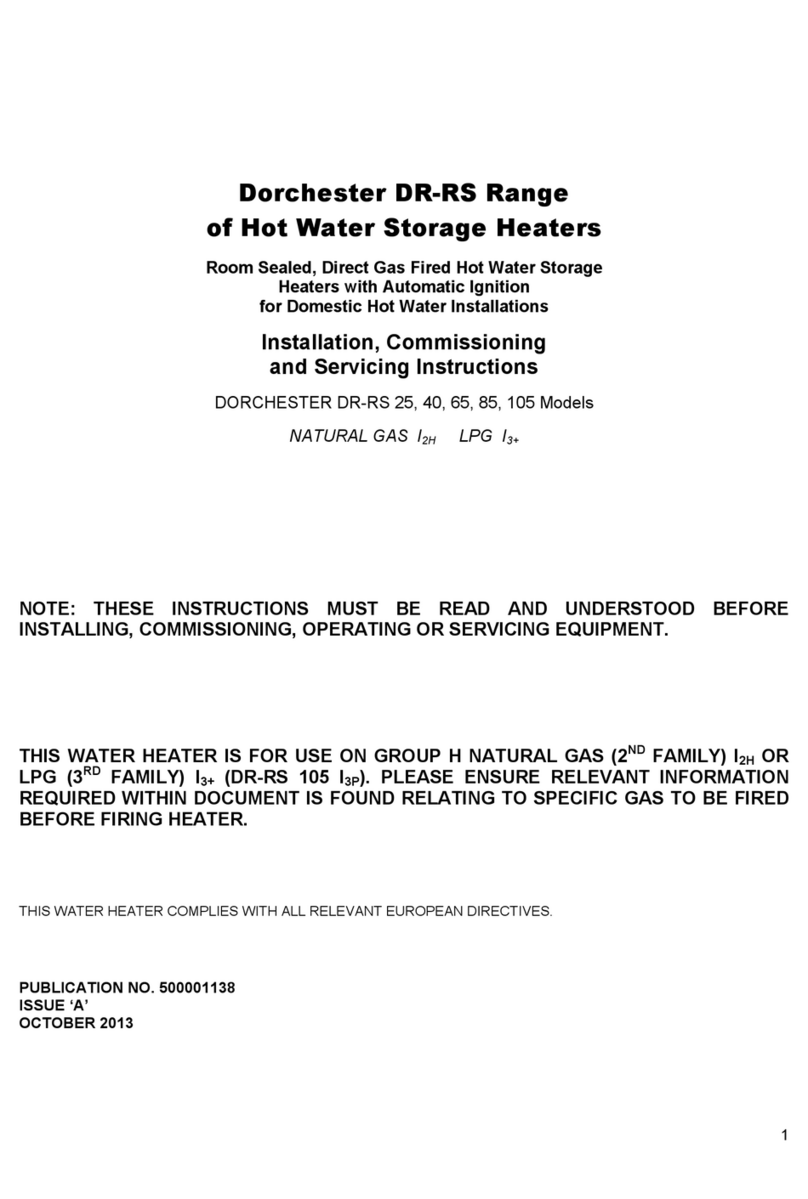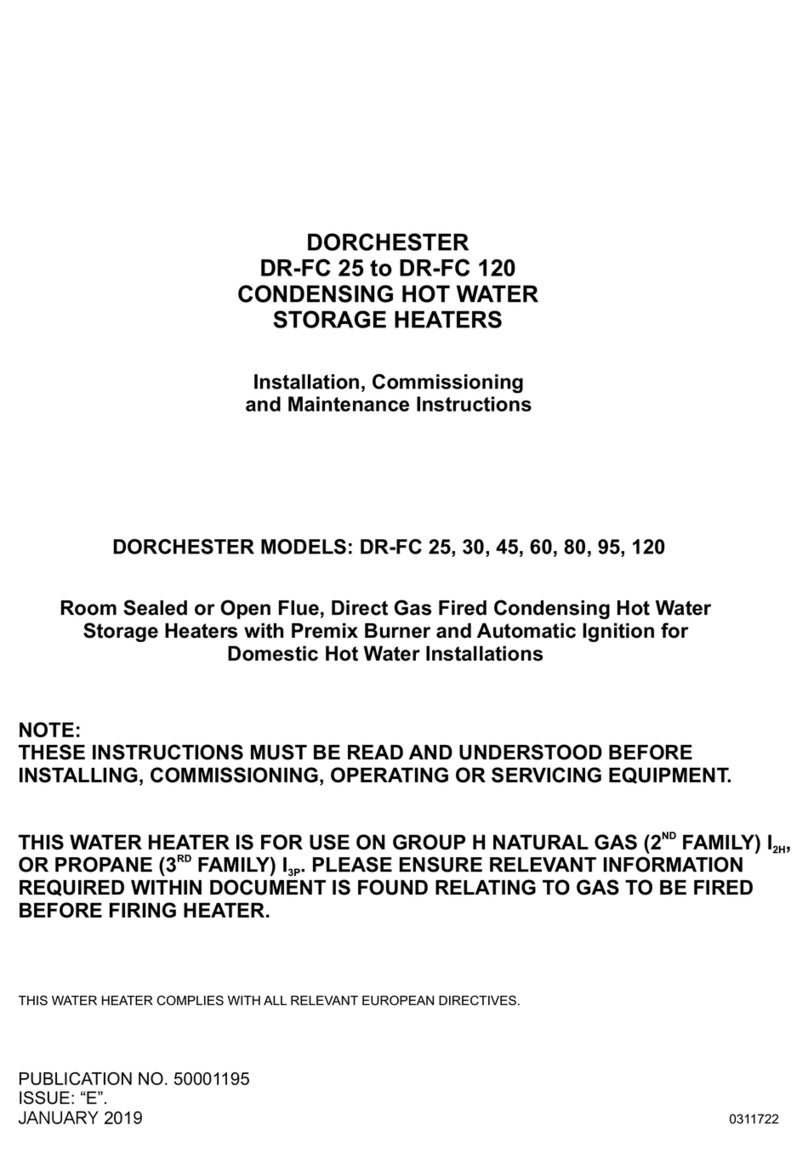Electrical connenction
Ionisation current
Theminimumionisationcurrentis0.9micro-AmperesDC.
Below this current the burner controller will assume no ame
is present. When in normal operation, the ionisation current
will be about 1.2 to 1.3 micro-Amperes DC when only the
pilot ame is burning.
(Adjust the main burner pressure to zero to be able to
measure under this condition).
With pilot and main burner in operation, the ionisation
current will be approx. 6.0 to 6.3 micro-Amperes DC.
Ionisation current can be measured by connecting a
universal meter in series with the connection to the ame
probe. Make sure meter is set for Direct Current. Alternating
Current gives no information about the system’s behaviour.
2. FOR THE INSTALLER
2.1 Installation
This water heater must be tted in a location that will permit
the provision of an approved ue system and adequate
ventilation.
A service clearance of 50 cm at the sides and rear of the
unit and 100 cm at the front of the unit must be allowed
for ease of servicing. Adequate distance must be allowed
between the top of the unit and any obstruction or ceiling to
allow the ue bafe and anode to be inspected, cleaned or,
in the case of the anode, replaced if necessary.
The water heater must stand on a level surface resistant
to heat, insulated in accordance with local by laws and
Building Regulations and with sufcient strength to support
the weight of the unit when full of water.
The heater must stand on its feet as supplied and the
space beneath the bottom casing kept clear as this is the
path for combustion air to enter the heater.
This water heater must not be installed in a bathroom,
bedroom or in a cupboard opening on to such rooms.
This water heater must not be installed in any area where
ammable materials are used or stored.
Insufcient ventilation may give rise to a risk of re,
explosion or suffocation. If in doubt consult the national
and local regulations governing the installation of gas
appliances or local gas service organisation.
2.1.1 Regulations and Related Documents
Gas Safety Installations and Use Regulations 1998,
(as amended). It is law that competent persons, in
accordance with the above regulations install all gas
appliances. Failure to install appliances correctly could
lead to prosecution. It is in your own interest, and that of
safety, to make sure that this law is complied with.
The installation of the boiler MUST be in accordance with
the relevant requirements of the Gas Safety Regulations,
Building Regulations, IEE Regulations and the Water
Supply (water ttings) Regulations.
The installation must also be in accordance with any
relevant requirements of the HSE, local gas region and
local authority and the relevant recommendations of the
following documents: -
British Standards
BS 6891: Specication for the installation of low-pressure
gas pipe work of up to 28 mm (R1) in domestic premises (2nd
family gas). For larger installations see IGE/UP/2 below.
BS 6798: Specication for installation of gas-red boilers
of rated input not exceeding 70 kW net.
BS 6644: Specication for installation of gas-red hot
water boilers of rated inputs between 70 kW and 1.8 MW
(net) (2nd and 3rd family gases).
BS 6700: Specication for design, installation, testing and
maintenance of services supplying water for domestic use
within buildings and their curtilages.
BS EN 806-2: Specication for installations inside
buildings conveying water for human consumption.
Part 2: Design.
BS 5546: Specication for installation of hot water
supplies for domestic purposes, using gas-red
appliances of rated input not exceeding 70 kW.
BS 5440: Installation and maintenance of ues and
ventilation for gas appliances of rated input not exceeding
70 kW net (1st, 2nd and 3rd family gases).
Part 1: Flues. Part 2: Ventilation.
Institute of Gas Engineers and Managers Publications
IGE/UP/1 Soundness testing and purging of industrial and
commercial gas installations.
IGE/UP/1A Soundness testing and direct purging of
small low-pressure industrial and commercial natural gas
installations.
IGE/UP/2 Gas installation pipe work, boosters and
compressors on industrial and commercial premises.
IGE/UP/10 Installation of gas appliances in industrial and
commercial premises. Part 1: ued appliances.
CIBSE Publications:- “CIBSE Guide”
Section B4 : Water Service Systems.
Some chemicals produce vapours that can cause
rapid failure of main and pilot burners and storage
tanks if they are drawn into the combustion air
supply.
Electrical supply Frequency Fuse
230 V AC 50 Hz 5 A


































